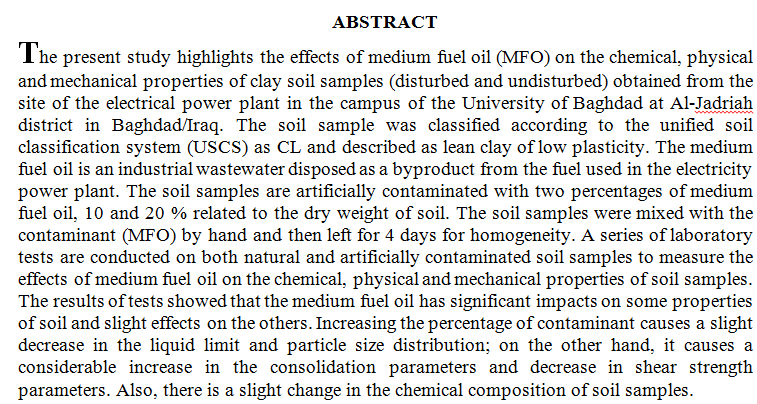
The Zubair reservoir in the Abu-Amood field is considered a shaly sand reservoir in the south of Iraq. The geological model is created for identifying the facies, distributing the petrophysical properties and estimating the volume of hydrocarbon in place. When the data processing by Interactive Petrophysics (IP) software is completed and estimated the permeability reservoir by using the hydraulic unit method then, three main steps are applied to build the geological model, begins with creating a structural, facies and property models. five zones the reservoirs were divided (three reservoir units and two cap rocks) depending on the variation of petrophysical properties (porosity and permeability) that results from IP software interpr
... Show More (4)
(4)
Building a geological model is an essential and primary step for studying the reservoir’s hydrocarbon content and future performance. A three-dimensional geological model of the Asmari reservoir in Abu- Ghirab oil field including structure, stratigraphy, and reservoir petrophysical properties, has been constructed in the present work. As to underlying Formations, striking slip faults developed at the flank and interlayer normal. Abu Ghirab oilfields are located on the eastern anticlinal band, which has steadily plunged southward. 3D seismic interpretation results are utilized to build the fault model for 43 faults of the Asmari Formation in Abu Ghirab Oilfield. A geographic facies model with six different rock facies types
... Show More (2)
(2)
Ultimate oil recovery and displacement efficiency at the pore-scale are controlled by the rock wettability thus there is a growing interest in the wetting behaviour of reservoir rocks as production from fractured oil-wet or mixed-wet limestone formations have remained a key challenge. Conventional waterflooding methods are inefficient in such formation due to poor spontaneous imbibition of water into the oil-wet rock capillaries. However, altering the wettability to water-wet could yield recovery of significant amounts of additional oil thus this study investigates the influence of nanoparticles on wettability alteration. The efficiency of various formulated zirconium-oxide (ZrO2) based nanofluids at different nanoparticle concentrations (0
... Show More (47)
(47)
 (36)
(36)
 (5)
(5)
Background: Sialosis described as a specific consequence of diabetes. In diabetic sialosis, the increased volume of the glands is due to the infiltration of adipose in the parenchyma. The B-scan ultrasonography is a generally accepted tool for determining parotid gland enlargement. Oral health is, to a greater extent, dependent on quality and quantity of saliva, both of which may be altered in diabetics. This study was established to detect the enlargement of parotid gland in diabetic patient and study the changes in physical properties of saliva and its relation with the salivary gland enlargement. Subjects, Materials and Methods: A cross-sectional study with highly specified criteria with ages ranged (20-65) years, male and female subject
... Show More (3)
(3)
Polycaprolactone is one of the natural biodegradable polymers mainly used in bioplastics production for packaging, usually composed of non-toxic compounds and biodegradable. The aim was to examine the role of zinc oxide (ZnO) nanopowder on the,wettability , thermal and anti-bacterial effect nanocomposites. Pure PCL and PCL-based bio- nanocomposites doped with various ratios of ZnO nanoparticles from 0% to 5wt% were prepared through the arrangement of throwing procedure. The results show that wettability properties in relation to ideal PCL and that they were increasingly hydrophobic from 57º.8 to 69º.53 because add ZnO nanocomposites,the thermal stability between 300 and 400 ° C makes them perfect for the application
... Show More (3)
(3)
Silver sulfide and the thin films Ag2Se0.8Te0.2 and Ag2Se0.8S0.2 created by the thermal evaporation process on glass with a thickness of 350 nm were examined for their structural and optical properties. These films were made at a temperature of 300 K. According to the X-ray diffraction investigation, the films are polycrystalline and have an initial orthorhombic phase. Using X-ray diffraction research, the crystallization orientations of Ag2Se and Ag2Se0.8Te0.2 & Ag2Se0.8S0.2 (23.304, 49.91) were discovered (XRD). As (Ag2Se and Ag2Se0.8Te0.2 & Ag2Se0.8S0.2) absorption coefficient fell from (470-774) nm, the optical band gap increased (2.15 & 2 & 2.25eV). For instance, the characteristics of thin films made of Ag2Se0.8Te0.2 and Ag2Se0.8S0.2
... Show MoreManganese-zinc ferrite MnxZn1-xFe2O4 (MnZnF) powder was prepared using the sol-gel method. The morphological, structural, and magnetic properties of MnZnF powder were studied using X-ray diffraction (XRD), atomic force microscopy (AFM), energy dispersive X-ray (EDX), field emission-scanning electron microscopes (FE-SEM), and vibrating sample magnetometers (VSM). The XRD results showed that the MnxZn1-xFe2O4 that was formed had a trigonal crystalline structure. AFM results showed that the average diameter of Manganese-Zinc Ferrite is 55.35 nm, indicating that the sample has a nanostructure dimension. The EDX spectrum revealed the presence of transition metals (Mn, Fe, Zn, and O) in Mang
... Show Morethis research seeks to shed light on the study of the impact of Putinism on the Russian-Ukrainian war that broke out in early 2022, by studying the contents of the speeches of Russian President Vladimir Putin before the start of the war. This research uses the structural approach in analyzing the components of the Russian political regime. The research tools used in this research include case studies, content analysis of Russian speeches, and personal meetings of researchers and specialists in Russian affairs. It sums up a number of important conclusions, most notably are : 1) Putinism is a totalitarian regime that includes the political doctrine during the era of Russian President Vladimir Putin. 2) Duginism represents the totality of t
... Show More
